Île-de-France tramway Line 4
| Tramway T4 | |
|---|---|
  | |
| Overview | |
| Stations | 11[1] |
| Daily ridership | 35,000 customers per day[1] |
| Website | SNCF Transilien-Les Lignes |
| Operation | |
| Opened |
2006[1] (last extension in 2006) |
| Rolling stock | Siemens Avanto S70 |
| Technical | |
| Line length | 7.9 km (4.9 mi) |
| Track gauge | 1,435 mm (4 ft 8 1⁄2 in) |
| Operating speed | 70 km/h (max) |
Line 4 of the Tramways in Île-de-France or the T4 is an 8-kilometre (5 mi) long[1] tram-train line operated by the SNCF. It was inaugurated 20 November 2006, and runs between Aulnay-sous-Bois and Bondy in the Seine-Saint-Denis department of Île-de-France.
It is the result of the transformation and installation of a double-track on the Bondy to Aulnay-sous-Bois line, or ligne des Coquetiers ("Egg Cup Line"), which opened in 1875. It thus became the first French tram-train line, an event whose true significance emerged during plans to expand it into a tramway and integrate it into the urban transport network.
History
The ligne des Coquetiers
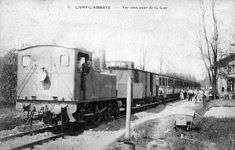
Line 4 of the Île-de-France tramway was known as the Bondy à Aulnay-sous-Bois rail line, or ligne des Coquetiers, and has linked the Nord and Est rail networks between Aulnay-sous-Bois and Bondy since 1875.
The "Egg Cup Line" fell into disuse because of line’s limited area and lacklustre service, which caused many traffic problems at its rail crossings. In 1993, the SNCF implemented some changes to reduce closure times at rail crossings and increase train frequency during rush hour (a train every fifteen minutes between Bondy and Gargan and every thirty minutes between Gargan and Aulnay). However, they failed to make the line more appealing to potential users, who remained uninterested because of its insufficient service level and the excessive length of the train's route.[2]
The line was thus shut down in December 2003 for major renovations to transform it into a hybrid between a train and an urban tramway: the tram-train.[3]
Transformation of the Line
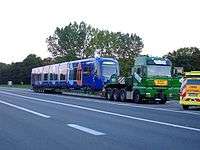
The development of the tram-train concept inspired plans to reinvigorate the ligne des Coquetiers using this system that seemed ideal. It solved the problems caused by the rail crossings by transforming them into simple road junctions. It reduced disruptions in the urban landscape and expanded the use of trams in urban transportation all while greatly increasing service. This technology was finally adopted, and in 2001 the SNCF called for European tenders for the trains and cars. In 2003 the draft was approved by the STIF, SNCF, and RFF.
Objectives

The work aimed to:[4]
- increase service throughout the day until 8 P.M., with trains scheduled every six minutes Monday to Saturday and every nine minutes on Sundays and statutory holidays. Between 8 P.M. and 10 P.M., trains were to be scheduled every nine minutes and every twelve minutes from 10 P.M. until the end of service. Service was also to be decreased for six weeks during the summer, from approximately 14 July to 31 August;
- build new stations to better respond to user demand;
- reduce disruptions of the urban landscape by railways by integrating tramways into cities in collaboration with the Seine-Saint-Denis department and the communes it travels through; and
- modify urban transportation networks by reducing wait times at signalized rail crossings.
The evolution toward urban transport modes was accompanied by physical modifications to the rail line by:
- doubling the track between Gargan and Aulnay-sous-Bois, rebuilding the overpass on RN 3, and enlarging the Rougemont Bridge on the de l'Ourcq Canal;
- building a new terminus at Bondy Station with an additional track;
- eliminating passenger buildings and turning rail stations into tramway-style stops. Only Gargan Station services trains since it houses the line's operations centre, where a central track leads to train storage;
- building three additional stops:
- Remise à Jorelle between Bondy and Les Coquetiers;
- Lycée Henri Sellier between Gargan and L'Abbaye ; and
- Rougemont – Chanteloup between Freinville – Sevran and Aulnay-sous-Bois; and
- turning rail crossings into road junctions with signalization that conforms to the highway code.
Work
Construction began in June 2004. The entire track was removed and reinstalled, the stations' platforms were demolished and rebuilt, the 25 kV catenary was rewired, and the Gargan-Aulnay section was made into a double-track. To do so, the Rougemont Bridge on the de l’Ourcq Canal was widened, and in June 2005 the RN3 overpass, which was built in 1932 as a single line, had a walkway installed.
Six months later, in January 2006, the biggest operation took place in front of many onlookers: the new double-track overpass' walkway was installed overnight after traffic was blocked on the ex-RN3. That same summer, the first train cars were sent by oversize load and put on the line for technical and safety tests.[5]
Cost
The T4 project was a part of the twelfth State-Region contract agreement. Financing for the transformation of the ligne des Coquetiers into the T4 Line, which totalled 52.72 million euros (January 2003 cost), was shared between:[6]
- the Île-de-France Regional Council: 46.94%;
- the French government: 23.47%;
- the RFF: 18.52% (which was partially soft loans from the Île-de-France Region);
- the Seine-Saint-Denis General Council: 9.26%;
- the SNCF: 1.82% (from soft loans from the Île-de-France Region).
The SNCF paid for the fifteen cars that were needed to operate on the line: a total of 68 million euros.[7] The annual cost of running the line is 11.2 million euros, which are provided by the STIF.[8]
Tram-train
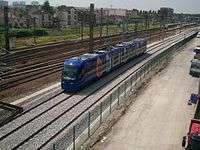
Line 4 of the Île-de-France tramway was inaugurated on Saturday, 18 November 2006, and was free of charge the entire weekend. Its true commercial operation began the morning of 20 November 2006.
The T4 is the Île-de-France network's fourth line and France's first tram-train line.[5] It is the first of its kind to be operated by the SNCF. Unlike the other Île-de-France tramway lines, which are operated by the RATP, this line is operated by the SNCF, which may seem surprising. The SNCF left the ligne des Coteux (now T2), which was then in disrepair and highly unprofitable, to the RATP during the 1990s.
The SNCF's policy was to concentrate on heavy fluxes of passengers and thus on heavy rail transit. The success of tramway networks and the increasing popularity of peri-urban transportation made the SNCF change its focus.
There are no plans to extend the line to Noisy-le-Sec. This would allow passengers to reach this multimodal hub and connect with the T1, the RER E (both the Tournan and Chelles-Gournay branches), the Tangentielle Nord, and a fortiori toward Paris.
The RATP's expansion of the T2 from Puteaux to La Défense on existing roadbeds contributed to the enormous success of that line. Despite this, the ability to operate with a 25 kV catenary is needed to reach the Noisy-le-Sec depot. The trains' dual-current abilities (25 kV / 750 V) are not used, since the entire line is powered in 25 kV.
The line is used by fifteen tram-train cars, which run on the right[9] as mandated by the Code of Conduct.[10] It takes nineteen minutes to travel the eight-kilometre line. As stated in its regulations, the cars and stations are carefully analyzed to make them easily accessible for the disabled.
Criticism
Despite the complete improvement of the service, the line's operations have not gone without criticism. On its initial day, 18 November 2006, two trains had damaged brakes, which caused the SNCF to interrupt service during the late afternoon, forcing many users to continue their trip on foot or by hitchhiking.[11]
Many other aspects of the new line drew complaints. The frequent use of audio warning devices by train operators caused friction between nearby residents and elected officials on the one hand and the SNCF on the other. This nuisance led to the creation of a collective of residents and local politicians who successfully reduced the volume of the audio devices by 15 dB in mid-March 2007.[12] Safety policies have since changed and the devices’ use is now limited to when there is immediate danger.[13]
Other users have complained about conceptual errors or unfinished infrastructure. Some pedestrian walkways remained inaccessible a year after the line opened; disabled people where unable to access certain points because of stairs; and the number of arches to store bicycles in the proposed shelters were reduced. The disappearance of some old passenger buildings against the wishes of some municipalities also caused controversy. A group supported by the municipalities was able to save Coquetiers and l'Abbaye Stations, but the l'Allée de la Tour Rendez-Vous building was destroyed.[14] A bicycle path was built along the line starting in spring 2008 and was opened in the beginning of 2010.[13]
Service Improvements
Service improvements were implemented on 8 December 2007. From then on, from 10 P.M. until the end of service, the tramway began connecting with the RER B train at Aulnay and the RER E at Bondy. Since that date, the line has been in service the nights of 31 December and the Fête de la musique.[13]
However, no changes are planned for the nearby bus routes that lead to the tramway, which could allow the line to reach its objective of 40,000 passengers a day. In October 2007, the line only carried 29,000 passengers daily[13] and 30,000 in 2009.[15]
Infrastructure

The T4 is a hybrid line. In most cases, French rail lines are electrified (when applicable) in 1,500 V or 25 kV, and use Vignole rails and a block signal system. These trains travel on the left.
The T4 Line is electrified in 25 kV and uses classic tracks like the national railway system instead of urban tram flange rails, which are flat tracks built into recesses in a road or greenspace. Instead, it has low platforms and its trains travel on the right. Like tramways, the line uses multi-aspect signalling, and crossings are equipped with traffic lights. Thus tram-trains exceed the capabilities of vehicles that can only travel on the national railway system or on urban tramway lines.
However, a true tram-train was not in use in 2011, but should be in the future with planned tramway extensions into urban areas (tramway tracks electrified in continuous 750 or 1,500 volts).
The line is also the first in France to use the GSM-R communications system, a standard ground-train radio link that is progressively being implemented throughout the French rail network.[16]
Layout and Stations
Route layout
The line departs from Bondy Station, which has two station tracks located beside the passenger building on the Paris-Est à Strasbourg-Ville Line (Line 1). It leaves from the north of the station and heads east to Remise à Jorelle Station before curving to the north. The flyover that was once used by trains heading toward Bondy and Paris-Est is now used to access the Noisy shop. The line then runs in between two one-way roads located beside the tracks. It stops at Les Coquetiers Station in Villemomble where the line is enclosed by Aulnay Boulevard, then Allée de la Tour-Rendez-Vous at the limits of Villemomble, Le Raincy, and Les Pavillons-sous-Bois.
The line then runs along Pasteur Boulevard, where it makes a stop at Les Pavillons-sous-Bois Station before making its way north. After it reaches Gargan Station, which is located between Louis-Pasteur and Roy Boulevards, it travels up the former RN3 overpass, now known as Aristide-Briand Avenue, before returning to ground level again. The train then runs between Édouard-Vaillant and Maurice-Berteaux Boulevards. A bit further, the line stops at the Lycée Henri Sellier Station, then the old L'Abbaye Station before following an S-shaped route westward. It then stops at Freinville-Sevran Station, runs along the former RN370, which is now called Westinghouse Boulevard, before crossing the de l'Ourcq Canal. From this point on, the train heads directly westward. It makes a stop at Rougemont-Chanteloup Station then reaches the La Plaine à Hirson line near the bifurcation at Roissy and runs along it for a few hundred metres. The train completes its journey at Aulnay-sous-Bois Station on two dead-end tracks 7,900 metres from the line's starting point.
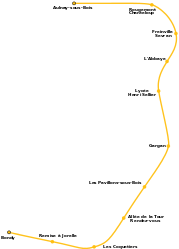
Shops
The line's fifteen tram-trains are maintained at shops in the de Paris-Est technicentre located in Noisy-le-Sec in Seine-Saint-Denis.[17] They were renovated after the creation of the RER E.[18]
This technicentre maintains the Transilien network's rolling stock for Paris-Est: the twenty-eight Z 20500 cars, the Transilien Line P's thirty rames inox de banlieue (stainless steel suburban cars) or RIB, and the fifty-three cars from the RER Line E.[17]
The maintenance area includes a 210- by 90-metre space with ten specialized tracks: one for simultaneous lifting, one for removing parts, two for cleaning, two tram-train repair pits, and four rolling stock repair pits. The shop also contains moveable lift baskets and bridge cranes. It also contains an outdoor beam for short-term servicing and cleaning operations. It has nineteen 245-metre-long tracks: five tracks contain repair pits with access to train roofs and fourteen tracks at ground level, four of which contain platforms.[17]
Operations
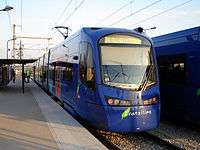
The T4 tram-train line is operated by the SNCF. It runs from approximately 4:30 A.M. to 1:20 A.M. year-round with fifteen U 25500 cars and travels from Bondy to Aulnay in approximately twenty minutes.
Service can occasionally be maintained continuously for twenty-four hours during important events such as the Fête de la musique or New Year's Eve. During these periods' special night service, called "Nuit Festive," (festive night) tram-trains run every half-hour.
Schedule
Monday through Saturday, the line operates as follows:
- between 4:30 A.M. and 6:00 A.M.: one tram-train every nine minutes;
- between 6:00 A.M. and 8:00 P.M.: one tram-train every six minutes;
- between 8:00 P.M. and 10:00 P.M.: one tram-train every nine minutes;
- between 10:00 P.M. and 1:20 A.M.: one tram-train every fifteen minutes.
On Sundays and statutory holidays, the line operates:
- between 4:30 A.M. and 10:00 P.M.: one tram-train every nine minutes;
- between 10:00 P.M. and 1:20 A.M.: one tram-train every fifteen minutes.
Rolling Stock

In 2011, the T4 Line used fifteen U 25500s trains built by Siemens called the Avanto: nine units for day-to-day operations, four in reserve, and two for maintenance.[19]
Since 4 July 2011, the line's reserve cars have also served the SNCF Esbly-Crécy rail shuttle.[20] However, in 2011, only a single car was needed for the shuttle. Multiple-unit traffic on the shuttle is possible, which uses two of the fifteen cars.
The Avanto rolling stock was chosen after a 2001 call for tenders by the SNCF to equip the line. German builder Siemens won the bid, Germany being where the tram-train concept originated. It was the first tramway-style train to be able to travel on French railways.
Each 37-metre-long unit is composed of five articulated sections and has a capacity of 242 passengers (80 seated). They are painted Transilien night blue with coloured swashes on the doors. The first car was delivered by road in November 2005 and 12 cars were ready to be put in service in November 2006. The stock has a maximum speed of 100 km/h, but is not operated that fast on the line.
Unit TT07 was named Jérémy, in honour of a young technician in the production-maintenance unit at Noisy-le-Sec who died during an accident in October 2006.[21]
Driving and Signalization

The speed limit on the line is 70 km/h. It is 50 km/h in urban areas (the majority of line) and 30 km/h when approaching crossings.
When the line opened, the SNCF created a new position: Tram-train conductor (conducteur Tram-Train (CRTT)). These conductors therefore only work on this line. Usually, conductors from one depot operate different types of trains based on need and regularly change lines.
Speed regulation is controlled by the conductors: the line contains only speed limit signs, route protection signals, and road crossing protection signals. For the former, the road network is equipped with classic R11-type tricolour lights and the rail line has R17 lights.
On a black background, a horizontal white line and a white circle means stop, and a vertical white line means go. An operating assistance signal completes the signalization: an illuminated lozenge indicating that a request for priority at a road crossing has been put in place.[22]
The route protection signals are located at switches and crossings. Speed limit signs are square panels with black numbers on a yellow background.[23]
Operating Staff
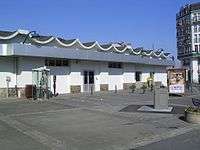
In 2005, the SNCF signed an agreement with the Seine-Saint-Denis General Council through its Paris-Nord and Paris-Est establishments. The agreement, called Passerelle-Emploi or "employment gateway," makes hiring new employees from within the department a priority. One-third of employees that were hired came from within the department. Out of forty-one employees, twenty-seven became conductors and fourteen became sales representatives.
In 2007, the line had fifty-nine conductors (seven of which were women), a head of motive power production, and two managers. It also had twenty-eight sales representatives and a train team coordinator and their assistant. Half of these employees were hired externally. The T4 also has twelve urban train dispatchers overseen by three department heads and seventeen managers, and a dozen employees to maintain the cars at the Noisy-le-Sec shop.
Safety is ensured by the railway police teams (SUGE) and onboard cameras, which allow conductors to see the inside of the car.[22]
There was some social conflict during the summer of 2012, leading to the use of replacement buses after the conductors' work organization was changed.[24]
Fare System
The T4 is the only tramway line in Île-de-France to not have adopted the ticket t+ upon its creation. Since it was operated by the SNCF, it stayed on the Transilien fare system. However, after a decision by the STIF in June 2007, the new ticket t+ that was adopted 1 July 2007 had to be used by the T4 by the first trimester of 2008.[25] Technical problems caused by the dual RATP/SNCF fare system delayed its implementation until 1 July 2008. Origin/destination tickets are still sold by the SNCF, but line-specific tickets no longer are.[26] Unlike the other Île-de-France tramways, fare validation occurs on the platforms; the cars do not have ticket-dating machines.
Traffic
In February 2007, traffic on the T4 line had risen to 21,000 passengers a day. By October 2007, it had reached 29,000.[13] The long term forecast for the line is 40,000 daily passengers.[27]
Expansion Project
Controversy: 2006-2013
The STIF has been planning to split the T4 tram-train toward the Clichy-Montfermeil plateau to serve the housing estates in these cities since 2003. It is one of the main plans for the Île-de-France region that were approved in 2008.

It would allow residents of Clichy-sous-Bois, Montfermeil, and nearby communes to reach Bondy (RER E) or Aulnay-sous-Bois (RER B) much faster than they currently do using the bus. It would create a new way to access major employment centres such as the Roissy-Charles-de-Gaulle Airport.[28]
Nevertheless, this extension was opposed by some of the cities it would cross (Livry-Gargan and Les Pavillons-sous-Bois). Since the 2008 municipal elections, the mayors of these cities have largely been against the project. The mayors did not want to oppose the electorate, who were unwilling to deal with the nuisances that would be caused by the expansion (noise, traffic, and the proximity of the plateau's disadvantaged population to their homes—particularly young people from housing estates). This political impasse led to the publication of a leaflet[29] and a protest by the plateau's elected representatives on the day of the tram-train's inauguration by officials.
During the Aulnay-Bondy T4 inauguration, Philippe Dallier, the Pavillons-sous-Bois mayor and Seine-Saint-Denis senator, reiterated that in 2000, Bondy's Socialist mayor (1995-2011) Gilbert Roger and he had written an e-mail signed by commune mayors from Pantin to Clichy-sous-Bois and Montfermeil requesting bus lanes on the former RN3. According to him, this proposal would have both solved the public transportation issue in the Clichy-Montfermeil plateau and dealt with the congestion on the route nationale that packed buses travelled with difficulty.
The STIF's T Zen 3 project, a bus rapid transit service, was selected to improve public transportation in the communes crossed by the former RN 3 from Porte de Pantin to Pavillon-sous-Bois. The new T4 branch will therefore open up plateau cities, particularly Clichy-sous-Bois and Montfermeil.
Other politicians regularly called for the separation, which according to them was essential to open up these populated areas. This was the case for Regional Councillor and President of the STIF's Investment and Contact State-Region Plan Follow-up Commission (Commission des investissements et du suivi du contrat de plan État-Région), Alain Amédro,[30] who requested the inclusion of the separation in the contract signed by the Region and Seine-Saint-Denis department. Similarly, Claude Dilain, the mayor of Clichy-sous-Bois (1995-2011), asked that the region finally start planning the branch.[31]
Fadela Amara, Secretary of State for Municipal Affairs (2007-2010), traveled to Clichy-sous-Bois on 9 November 2007, by RER and bus from Paris so she could assess the length and quality of public transportation from the capital.[31] She thus stated, "I will do everything to make the work start as soon as possible."[13]
The vice-president of the Region (1998-2010) and the STIF, Serge Méry, thus asked the French government to finance 30% of the project's cost, which would allow work to begin in 2011. By default, the Île-de-France Region would ask the Seine-Saint-Denis department for financing.[13]
The Île-de-France 2007-2013 State-Region project contracts already have planned funding for studies to "determine in 2010 what operations[32] can be awarded credits for substantial progress before" 2013.[33]
In July 2008, the STIF approved the main objectives and characteristics dossier of the expansion.[34] Two routes were retained out of the six that were studied:
- One was based around a double branch between Gargan and Lycée Henri-Sellier Stations, with a new 5.8-kilometre urban stretch with ten stations to be used by an estimated 5.7 million commuters by 2015 at a cost of 209 million euros.
- The alternative included only one branch toward Aulnay-sous-Bois at Freinville-Sevran Station, with a new 6.7-kilometre-long route with ten stations, to be used by an estimated 5.4 million commuters by 2015 at a cost of 220 million euros.

The proposed routes that crossed Raincy and Pavillons-sous-Bois were not included in this document. However, the Livry-Gargan commune requested that the CNDP present all the proposed routes created during the feasibility studies at the preliminary public debates and discussions. Consultations were postponed until 2009 because of a protest stating that all variants must be presented.
On 10 June 2009, a banner demanding the tram was attached to the front of the Clichy-sous-Bois and Montfermeil City Halls and a website was launched by the Clichy-sous-Bois/Montfermeil urban conglomeration community (CACM).[35] These were the turning points for these two cities to support the tram.
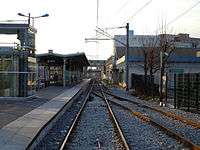
The official consultation ran from 1 September 2009 to 31 October 2009.[36] This consultation confirmed the advantages of the project even though its impact would only be further analyzed in the study's next phases. All seven variants were presented. The STIF decided to proceed with studies and consultations based on the two most appropriate proposals (no 3 and no 4), both of which included a branch toward Bondy, to analyze the consequences on the line's operations and automobile traffic. Proposals that avoided Bas-Clichy or that had longer travel times were largely rejected during the discussions.[37] The "0" proposal, which was called historic, was rejected because of the difficulties of inserting rails on Roy Boulevard and on the former RN 3.
Follow-up studies were prepared throughout 2010. The studies were split between the project's actors: the STIF managed the insertion studies (including traffic studies); the RFF took care of rail studies; and the SNCF executed operations studies.
In 2011, public workshops were organized in Montfermeil and Livry-Gargan to inform the population about work progress and start a dialogue with project owners to refine the project and gather residents' opinions.[38]
A public inquiry was held between 10 December 2012, and 24 January 2013,[39] in eight communes chosen by the board of inquiry. Pavillons-sous-Bois, Livry-Gargan, Clichy-sous-Bois, and Montfermeil were chosen because they would be crossed by the new infrastructure, while Villemomble, Le Raincy, Bondy, and Noisy-le-Sec (for access to its maintenance and storage facilities) were selected because they would be affected by the doubling of the T4's service at the Bondy-Montfermeil connection.
The board gave a clean opinion of the declaration of public utility of the new T4 branch and had three recommendations.
Final Layout
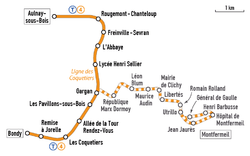
Layout no 4 was adopted by the STIF Council on 11 April 2012.[40][41] The new T4 branch will therefore create a direct route between Clichy-sous-Bois and Montfermeil. It will connect with the RER E and the forthcoming Line 15 of the Grand Paris Express in Bondy and the forthcoming Line 16 of the same network in Montfermeil.[42]
This six-kilometre-long route will include eleven new stations built on average of every 400 to 600 metres; an estimated 38,000 passengers are expected to travel daily along the section between Bondy and Montfermeil. Service between Bondy and Montfermeil will be as frequent as between Aulnay and Bondy, or every six minutes. On the route between Bondy and Gargan, where passengers can alternately connect with the Bondy-Aulnay and Bondy-Montfermeil tramways, service will be doubled. The average length of the route between Bondy and Montfermeil is estimated at slightly less than thirty minutes.[40]
The new T4 branch will depart from Gargan Station in the Pavillons-sous-Bois commune, which will also be the terminus of the forthcoming T Zen 3. It will partially cross the Town of Livry-Gargan (de la République and Marx-Dormoy Boulevards and Léon-Blum Avenue), then Clichy-sous-Bois (Romain-Rolland and Maurice-Audin Alleys),and Montfermeil (Utrillo Street, Jean-Jaurès Avenue, 8-Mai-1945 Street, Général-Leclerc Street, and Henri-Barbusse Street) where the T4 will make a one-way loop downtown. The terminus will be located at the station in the intercommunal hospital centre.
The cost of the T4 branch project is estimated at 214 million euros (excluding taxes), with an additional 60 million euros (excluding taxes) for rolling stock at January 2011 rates.[40]
New T4 Branch Project Participants
The new T4 branch project is one of the first owned by the STIF.
As the head of the entire project, it oversees deadlines and costs. It is also the project owner of the new urban section; it manages communications and actively seeks dialogue with concerned communes.
It entrusted part of the project ownership to:[43]
- the RFF for infrastructure elements from the national rail network; and
- the SNCF for materials related to transportation services operations.
Project Schedule
Work may start in 2014 and service would begin in approximately 2017.[40]
Rolling Stock for the Clichy-Montfermeil Extension
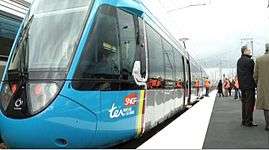
The rolling stock will be the Citadis Dualis, Citadis' version of the tram-train, which is 2.65 m wide and 42 m long. Its flat, 38-centimetre-high floor can transport 250 passengers, including persons with mobility impairment. The stock will have an on-board display system.[44]
Other Projects
The line's extension to the multi-modal hub Noisy-le-Sec (T1, Tangentielle Nord) is also part of the Île-de-France region's blueprint. Some groups are calling for the line to extend to Paris to avoid transfers. Another extension is planned toward the north to Garonor and the O'Parinor shopping centre via the former RN2 and the RN 370 at Rougemont-Chanteloup.
The route proposal at Bondy, with its single-track tram-train flyover above "Line 1," could include a connection toward Noisy-le-Sec and Paris, but it would require a crossing of the two tramway tracks (the train would run in tramway mode on the right and in train mode on the left). The current would remain at 25 kV. In Aulnay, with the exception of a track leading to unelectrified storage, which crosses the tramway tracks without a junction, the two networks are independent.
Appendixes
Related Articles
- Transilien Paris-Est
- Paris-Strasbourg Railway (called Line 1)
- Tramways in Île-de-France
- Transilien
- Syndicat des transports d'Île-de-France (STIF)
External links
- La fin de la ligne des Coquetiers [French]
- T4 Clichy-Montfermeil official website [French]
Bibliography
- Jean Tricoire, Le Tramway à Paris et en Île-de-France, La Vie du Rail, 2007, 143 p.
- Plaquette sous la direction de Jean-Barthélémi Debost (service du patrimoine culturel - Conseil général de la Seine-Saint-Denis),La ligne des Coquetiers (1875 - 2006) : de Bondy à Aulnay, un chemin de fer au service du développement local, Éditions du Conseil général, Bobigny 2007, 12 p.
- Gérard Géraud, Michel Mérille, La Ligne de M. Gargan. L’histoire ferroviaire de l’Est parisien, Les Pavillons-sous-Bois, Amarco éd., 2004, 351 p, ISBN 2-9509571-8-8
References
- 1 2 3 4 "BIENVENUE SUR LA LIGNE T4" [WELCOME TO THE T4 LINE]. sncf.com (in French). SNCF Transilien. 2013. Retrieved 2013-09-13.
- ↑ Jean Tricoire, Le Tramway à Paris et en Île-de-France, p. 127.
- ↑ Jean Tricoire, Le Tramway à Paris et en Île-de-France, p. 128.
- ↑ STIF Press Release: T4 - Ligne des Coquetiers (Aulnay-Bondy), une nouvelle offre de transports (4 May 2006) archive
- 1 2 Jean Tricoire, op. cit., p 128.
- ↑ Transilien - Le futur tram-train Bondy-Aulnay : fréquent pratique et rapide archive
- ↑ SNCF - Tram-train : ça roule ! archive
- ↑ STIF -Board of Directors - 10 May 2006 archive
- ↑ As opposed to most trains in France, which run on he left.
- ↑ Which is different from the usual restricted speeds of the RFF
- ↑ Blog du Raincy - Saturday, 18 November 2006, Inauguration (suite et gag) archive
- ↑ "Le gong du tram-train fera moins de bruit," Le Parisien, 15 March 2007.
- 1 2 3 4 5 6 7 Le Parisien, Edition 93, 19 November 2007
- ↑ Gares en péril
- ↑ STIF - Ligne 5 du tramway bientôt sur les rails archive
- ↑ RFF Press Release - T4 : Un tram-train dans la ville, p. 3 rchive
- 1 2 3 Association des usagers de la ligne Paris-Meaux/Crécy - Présentation du Technicentre de Paris-Est archive
- ↑ RFF - Bilan LOTI du RER E
- ↑ STIF - Press Release "T4 – Ligne des Coquetiers 'Aulnay – Bondy'" archive
- ↑ Site des usagers Paris-Meaux-Crécy - "La Ligne Esbly-Crécy" archive
- ↑ Le Parisien, edition 93, 19 November 2007
- 1 2 RFF Press Release - T4 : Un tram-train dans la ville archive
- ↑ Jean Tricoire, Le Tramway à Paris et en Île-de-France, p 141.
- ↑ Fin de conflit sur la ligne T4, Le Parisien, 8 August 2012.
- ↑ STIF Council Press Release 6 June 2007 archive
- ↑ Sur le T4, le ticket spécial va se faire cuire un œuf, Métropole, 30 June 2008.
- ↑ Livry-Gargan Magazine, November 2006
- ↑ Ville et Transports Magazine, 8 November 2006
- ↑ Leaflet published by the Clichy left
- ↑ Alain Amédro is the Green Party's regional councillor in Seine-Saint-Denis and an Aulnay-sous-Bois municipal councillor
- 1 2 Le Parisien, Seine-Saint-Denis edition, 9 November 2007
- ↑ The CPER cites four projects that will have to be prioritized in these choices: "the improvement and/or doubling of Line 13," "splitting off the T4 at Clichy/Montfermeil," "the Gonesse tread," and "the extension of Line 11."
- ↑ CPER Île-de-France archive
- ↑ Dossier of Main Characteristics and Objectives
- ↑ Vite, un tram jusqu'à Clichy Montfermei l
- ↑ Concertation T4 - Tram-train jusqu'à Clichy-sous-Bois et Montfermeil
- ↑ Consultation Report
- ↑ Downloadable workshop minutes,
- ↑ Board of Inquiry Assessement - Tramway T4 jusqu'à Clichy-sous-Bois et Montfermeil
- 1 2 3 4 STIF Press Package - April 2012 archive
- ↑ Le T4 a trouvé sa voix, Le Parisien, 12 April 2012.
- ↑ Implantation de la gare de Clichy - Montfermeil de la ligne rouge du Grand Paris Express et correspondance avec la ligne 4 du tramway archive
- ↑ Le raccordement actuel avec la ligne T4
- ↑ T4 jusqu'à Clichy-sous-Bois/Montfermeil – 28 November 2011 Workshop
| Wikimedia Commons has media related to Île-de-France tramway ligne 4. |